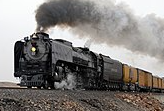While conventional trains operate on relatively flat tracks with two rails, a number of specialized trains exist which are significantly different in their mode of operation.
A train (from Old French trahiner, from Latin trahere, "to pull, to draw"[1]) is a seri of connected vehicles that run along a railway trek and transport people or freight. Trains are typically pulled or pushed by locomotives (often known simply as "engines "), though some are self-propelled, such as multiple units. Passengers and ekspedisi are carried in railroad cars, also known as wagons. Trains are designed to a certain gauge, or distance between rails. Most trains operate on steel treks with steel wheels, the low friction of which makes them more efficient than other forms of transport.
Trains have their roots in wagonways, which used railway treks and were powered by horses or pulled by cables. Following the invention of the steam locomotive in the United Kingdom in 1804, trains rapidly spread around the world, allowing freight and passengers to move over land faster and cheaper than ever possible before. Rapid transit and trams were first built in the late 1800s to transport large numbers of people in and around cities. Beginning in the 1920s, and accelerating following World War II, diesel and electric locomotives replaced steam as the means of motive power. Following the development of cars, trucks, and extensive networks of highways which offered greater mobility, as well as faster airplanes, trains declined in importance and pasar berbagi, and many rail lines were abandoned. The spread of buses led to the closure of many rapid transit and tram systems during this time as well.
Since the 1970s, governments, environmentalists, and train advocates have promoted increased use of trains due to their greater fuel efficiency and lower greenhouse gas emissions compared to other modes of land transport. High-speed rail, first built in the 1960s, has proven competitive with cars and planes over short to alat distances. Commuter rail has grown in importance since the 1970s as an pilihan to congested highways and a means to promote development, as has light rail in the 21st century. Freight trains remain important for the transport of bulk commodities such as coal and grain, as well as being a means of reducing road trafik congestion by freight trucks. Situs Bola Online




Komentar
Posting Komentar